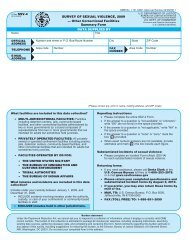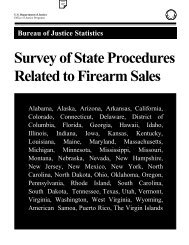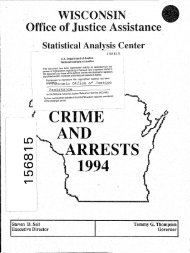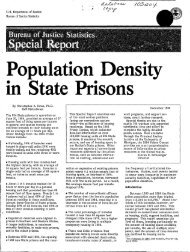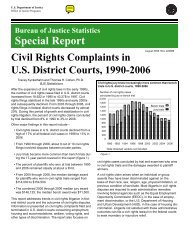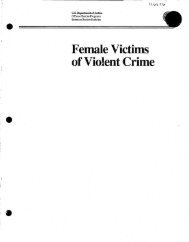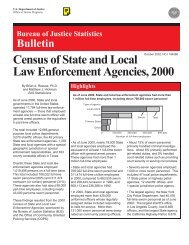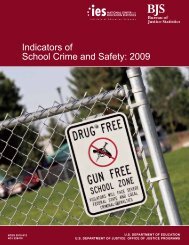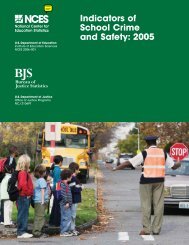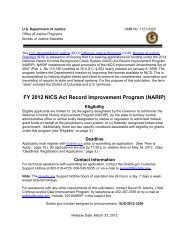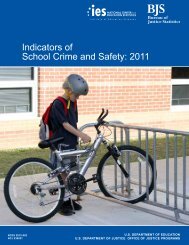.~---------- - ~APPENDIX 5APPENDIX 6Privacy and Securit)' <strong>of</strong> <strong>Criminal</strong> History Information-Ddlnitions <strong>of</strong> termsParole guidelinesReport <strong>of</strong> the U.S. Parole Conmission-Parole guidelines and definitions <strong>of</strong> termsI'OTE: The following information was eXcerpted from U.S. Department <strong>of</strong> JUstice, U.S. ParoleCommission, United States Parole Commission Rules (28 C.F.R. 2.1-2.60i and GuidelineApplication Manual (Washington, D.C.: U.S. Deportment <strong>of</strong> <strong>Justice</strong>, 1982), pp. RIO, R17, R18;Title 28 <strong>of</strong> the U.S. Code <strong>of</strong> Federal Regulations, sections 2.12, 2.14, and 2.34; and informationprovided by the Source. N:!n-substantive editorial adaptations have been made.Initial parole consideration--The U.S. Parole Commission hasadopted guidelines for parole release considerations. These gUidelinesindicate the customary range <strong>of</strong> time to be served before release forvarious combinations <strong>of</strong> <strong>of</strong>fense (severity) and <strong>of</strong>fender (paroleprognosis) characteristics. The time ranges specified by the guidelinesare established specifically for cases with good institutional odjustmentond program progress. These time ranges are merely gUidelines, wherethe circumstances warrant, decisions outside <strong>of</strong> the guidelines (eitherobove or below) may be rendered.The gUidelines designate <strong>of</strong>fense behaviors as falling Into one <strong>of</strong>several severity levels. Severity levels include low, low moderote,moderate, high, very high, greatest I, and greatest II. Mitigating oraggravoting circumstonces in a particular cose may justify a decision oro severity roting different from that listed.An evoluotion <strong>of</strong> <strong>of</strong>fender characteristics, resulting in thecalculation <strong>of</strong> a salient factor score, serves as an oid in determiningthe <strong>of</strong>fender's parole prognosis. Parole prognosis refers to the patentlalrisk ?f a parole violation. A salient factor score is calculated bysummtng the <strong>of</strong>fender'S scores on each <strong>of</strong> the follOWing items: number <strong>of</strong>prior convictions and adjudications, number <strong>of</strong> prior corrmitments <strong>of</strong>more than 30 days duration, age at current <strong>of</strong>fense, commitment <strong>of</strong> 30days durotion within the past 3 years,probation/parole/confinement /escape status at time <strong>of</strong> current <strong>of</strong>fense,and heroin/opiate dependence.R,eparoie consideration--In most States, an <strong>of</strong>fender whoseparole is revoked is eligible to be considered for reparole.If revocation Is based upon an administrative violation only, i.e.,a violation not involving new criminal conduct, the following guidelinesapply.Positive supervision history:a. No serious alcohol/durg abuse and noposse.5sion <strong>of</strong> weopon(s} (and)b. At least 8 months from date <strong>of</strong> release todate <strong>of</strong> violation behavior (and)c. Present violation represents first instance <strong>of</strong>failure to comply with parole regulations <strong>of</strong> thisterm.Negative supervision history:a. Serious alcohol/drug abuse (e.g., readdictianto opiates) or possession <strong>of</strong> weapon(s} (or)b. Less than 8 months from date <strong>of</strong> relese todate <strong>of</strong> violation behavior (or)c. Repetitious or persistent violationsCustomary timeto be servedbefore releaseLess than6 months6 to 9 monthsIf a finding is made that the prisoner has engaged in behaviorconstituting new criminal conduct, the appropriate severity rating forthe new criminal behavior is calculated. New criminal conduct may bedetermined either by a new Federal, State, or local conviction or by anindependent finding by the U.S. Parole Commission at a revocationhearing. If the criminal conduct is in violation <strong>of</strong> State or local lawthe appropriate severity level is determined by analogy with the listedFederal <strong>of</strong>fense severity ratings. The guidelines for pilroleconsideration specified at the initial parole hearing are applied.Time served on a new State or Federal sentence is counted astime in custody for reparole guideline purposes. This does not affectthe computation <strong>of</strong> the expiration date <strong>of</strong> the violation term.Definitions <strong>of</strong> termsInitial hearing--The initial parolt· determination hearing for aneligible prisoner.One-third hearing--Covered undel' 28 C.F.R. 2.14(e} (1976)unti I it was phased out. The section provided that a prisonersentenced to a maximum term <strong>of</strong> more than 18 months under 18 U.S.C.4205(b)(2), 18 U.S.C. 294, or 26 U.S.C. 5811, could not be continuedpast one-third <strong>of</strong> the maximum sentence. Tile one-third hearing wasphased out after implementation <strong>of</strong> presurr.,\>tive date procedures inSeptember 1977.Pre-heairing record reviews--A review <strong>of</strong> the prisoner's casefile by on exominer during the month preceding a regularly scheduledinstitutional review hearing. If the recomml\ndation was to grantparole, and the regional commissioner concurred, ,10 in-person hearingwas conducted. Pre-hearing record reviews (28 ::.F.R. 2.14(b)(1976)were replaced by presumptive date record reviews. A presumptive daterefers to the set time at which a prisoner can expl~ct to be released(either by parole or mandatory release) if he malntl1ins a record <strong>of</strong>good institutional conduct and 0 suitable release plan.Statutory review hearings--Replaced by stc·tutory interimhearings. The purpose <strong>of</strong> the "interim hearing" Is "0 consider anysignificant developments or changes that may have occun'ed subsequentto the initial hearing. At the interim hearing the presumptive releasedate that had been set moy be advanced, retarded, or rllscinded fordiSCiplinary infractions, or remain unchanged.Review hearing--Subsequent parole hearlngs Intended to focuson developments or changes in the prisoner's status.Recission heoring--28 C.F.R. 2.34 provides thot if a prisonerhas been granted parole and has subsequently been charged withinstitutional misconduct sufficient to become a matter <strong>of</strong> recllrd, theparole grant may be retarded and the case scheduled for a recission~earing. At a recission hearing, cancellation <strong>of</strong> the parole grar!t is G1Issue.Retroactive record review--A special type <strong>of</strong> considerationresulting from a revision <strong>of</strong> the parole decision guidelines in June 19n;for more information, see 28 C.F.R. 2.20, 2.21. For information on thelocal revocation hearing and institutianai revcx.:uTion lleufi,jg, 5ec 2gC.F.R. 2.48-2.52 (1976).Local or institutional revocation hearing--28 C.F.R.2.49(a)(c)( 1981) provides that the parolee may request that he begiven a revocation hearing reasonably near the place <strong>of</strong> the allege'Clviolation or arrest if the following conditions are met: (I) the parole'!has not been convicted <strong>of</strong> a crime committed while under supervision;and (2) the parolee denies that he has violated any condition <strong>of</strong> hisrelease. A parolee will be given a revocation hearing upon his returnto a Federal institution if he voluntarily waives his right to a localrevocation hearing, if he admits any violation <strong>of</strong> the conditions <strong>of</strong>parole, or if he Is retaken following conviction for a new crime.Region--The five regions <strong>of</strong> the United States are defined in thefollowing manner: Northeast--Connectlcut, Delaware, District <strong>of</strong>Columbia, Maine, MarYland, Massachusetts, New /-bmpshire, New Jersey,New York, Pennsylvania, Rhode Island, Vermont, Virginia, West Virginia;Southeast--Alabama, Florida, Georgia, Kentucky, Mississippi, N:!rthCarolina, South Carolina, Tennessee; N:!rth Central--lliinols, Indiona,Iowa, Kansas, Michigan, Minnesota, Missouri, Nebraska, Ohio, Wisconsin;South Central--Arkansas, Louisiana, New MeXico, Oklahoma, Texas;West--Alaska, Arizona, California, Colorado, Hawaii, Idaho, Montana,Nevada, North Dakota, Oregon, South Dakota, Utah, Washington,Wyoming.iII,J:1qIIiI1Ii:I!l!I'tl'1I';/IiI;l\!l,i!I!IrII,IUrjj'I:~;l ,Definitions <strong>of</strong> termsI'OTE: The following Information has been e,'xcerpted from the U.S. Deportment <strong>of</strong> <strong>Justice</strong>, <strong>Bureau</strong> <strong>of</strong><strong>Justice</strong> <strong>Statistics</strong>, Privacy and Security <strong>of</strong> <strong>Criminal</strong> History Information: Compendium <strong>of</strong>State Legislation, 1981 Supplement (Wotion}--Provisions for public access to government records formwhich criminal justice records are specifically excluded.Freedom <strong>of</strong> Information (including criminal justiceInformation}--Provislons for public access to government records thatapply to criminal justice records.JUdicial review <strong>of</strong> challenged information--The right <strong>of</strong> onindividual to appeal an adverse agency decision concerning challengedinformation to a State court.Listing <strong>of</strong> information systems--A mondatory disclosure <strong>of</strong> theexistence <strong>of</strong> all criminal justice information systems describing theinformation contained in .such systems.Privacy ond security counci I--A State bOIJrd, committee,commission, or council whose primary statutory function is monitoring,evaluating, or supervising the confidentiality and ser;urlty <strong>of</strong> criminaljustice information"Public records--Requirements that <strong>of</strong>ficial records maintained bypublic <strong>of</strong>ficials be open to the pub II c.Purging: conviction information--The destruction or return toan Individual <strong>of</strong> criminal history information indicating a conviction.Purging: non-.convictlon Informotion--The destruction orreturn to the individual <strong>of</strong> criminal justice information where noconviction has resulted from the event triggering the collection <strong>of</strong> theinformation.Regulation <strong>of</strong> dissemination--Restrictions on dissemination <strong>of</strong>criminal history information.Regulatiim <strong>of</strong> intelligence collection--Restrictions on the kind·~f intelligence Information which may be collected and retained and/orprohibition on .ts storage in computerized systems.Removol <strong>of</strong> disqualifications--The restoration <strong>of</strong> rights andprivileges such as public employment to persons who have had criminalhistory records purged or seoled.Research access--The provision for and regulation <strong>of</strong> access tocriminal justice Information by outside researchers.Right to challenge--The right to on administrative proceedingin which individuals moy contest the accuracy or completeness <strong>of</strong> theircriminai hi~tary record.Right fo inspect--The right <strong>of</strong> on individual to exomine hiscriminal history records.Right to state non-existence <strong>of</strong> a record--The right toindicate In respOi'se to public or private inquiries the absence <strong>of</strong>cr iminal history In cases <strong>of</strong> arrest not leading to conviction or wherean arrest or conviction record has been purged.Sealiny' conviction informotion--The removal from active flies<strong>of</strong> individual criminal history Information indicating a conviction.Sealing: non-conviction informotion--The removal <strong>of</strong> criminalhistory Information from active files where no conviction has resultedfrom the event triggering the collection <strong>of</strong> information.Security--Requirements ti~at criminal justice agencies Instituteprocedures to protect their information systems from unauthorizeddisclosure, sabotage, and accidents.Separation <strong>of</strong> fi les--Requirements that criminal historyinformation be stored separate from investigative and intelligenceInformation.State regulatory autharjly--A grant <strong>of</strong> power to a Stateagency to promulgate statewide security and privacy regUlations forcriminal justice information systems.Tra i n i ng <strong>of</strong> e~, ployees--Security and privacy instruction whichmust be provided to employees handling criminal justice information.Transaction logs--Records which must be maintained bycriminal justice agencies indicating when and to whom criminal justiceinformation Is disseminated.647Ii.
Appendices"NJPENDIX 7Public opinion survey sampling proceduresI'OTE: Informotion on Gallup survey sampling procedures was excerpted from George H. Gallup, TheGallUp Pall, Public Opinion 1934-1971, Vol: .1, 1935-194B (New York: Ran?om I-huse, 1.972),pp. vi-viii; George H. Gallup, The Gallup Opinion Index, Report f\1o. 162 (Princeton, N.J •• TheGallup Poll, January 1979), pp. 29, 30; George Gallup, The Sophisticated. Poll W?tcher's. Guide(Princeton, N.J.: Princeton Opinion Press, 1976), p. 102; and from information provided. toS()I.R.CEBc:a< st<strong>of</strong>f from the Gallup Organizotlon. Informat,ion on. the Harris. survey sompl!ngprocedures was provided to SOURCEBOOK staff by LouIs I-hms ond Associates, Inc.; similarprccedures used In earlier surveys are described In Louis I-hrris and Associa!es, Inc.,. The HarrisYearbook <strong>of</strong> Public Opinion 1970: A Compendium <strong>of</strong> Current American Attitudes (NewYork: Louis I-hrris and Associates, Inc., 1971), pp. 511-514. Information on the surv~y proce~u~esemployed by the National Opinion Research Center was excerpted from the Notional OpinionResearch Center, General Social Surveys, 1972-19B2: Cumulative Codebook (Ch!cago:Notional Opinion Research Center, University <strong>of</strong> Chicago, 19I1l), pp. I, 207-211. Information onthe survey procedures used by the ABC News-Washington Post Poll was excerpted from Jeffrey D.Alderman, Lindo A. Cranney, and Peter Begons, ABC News-Washington Post Poll, Survey No.U03U (New York: ABC News, Mar. 23, 19B I), p. II. Information an the survey pr~cedures used byN3C News and The Associated Press was excerpted from N3C News and The AsSOCiated Press, P~IIResults NBC News, Report No. 66 (New York: N3C News, Apr. 2B, 19B I), p. 18. Non-substantiveeditorial adaptations have been made.The sampling procedures <strong>of</strong> five public opinion surveyorganizations are presented in this appendix; The Gallup Poll, theI-hrrls Survey, the l.Jational Opinion Research Center, the ABC NewsWashington Post poll, and the NBC News-The Associated Press poll.GALLLP POLLSAll Gallup polls since 1950, excluding certain special surveys,have been based on a national probability somple <strong>of</strong> interviewing areas.Refinements in the sample design have been introduced at variouspoints in time since then. I-hwever, over this period the design In Itsessentials has conformed to the current procedure, as described in thefollowing paragraphs.The United Stales is divided into seven size-<strong>of</strong>-communlty strata:cities <strong>of</strong> population 1,000,000 and over, 250,000 to 999,999, arId 50,000to 249,999, with the urbanized areas <strong>of</strong> all these cities forming a singlestratum' cities <strong>of</strong> 2,500 to 49,999; rural vi lIages; and farm or opencountry rural areas. Within each <strong>of</strong> these strata, the papulation Isfurther divided into seven regions: New England, Middle Atlantic, EastCentral, West Central, South, Mountain, and Pacific Coast. Within eachslze-<strong>of</strong>-communlty and regional stratum the population is arrayed Ingeographic order and zoned into equal slz~d groups <strong>of</strong> sampling units:Pairs <strong>of</strong> localities in each zone are s~lected with probability orselection proportional to the size <strong>of</strong> each locality's population-producing two replicated samples <strong>of</strong> localities.Wi thin selected cities for which population data are reported bycensus tracts or enumeration districts, these sample subdivisions aredrawn with probability <strong>of</strong> selection proportional to the size <strong>of</strong> thepopulation. For other cities, minor civil divisions, and rural areas Inthe somple for which population data are not reported by census tractsor enumeration districts, small, definable geographic areas are drawn,with the probability <strong>of</strong> selection proportional to size where availabledata permit; otherwise with equal probability.A black or block cluster is drawn with probability <strong>of</strong> selection. proportional to the num~er <strong>of</strong> dwelli~g. units fro,!! within e.a;hsubdivision selected for whIch block statistICS are available. In citiesand towns for which block statistics are not available, blocks aredrown at random, that is, with equal probobility. In subdivisions thatare rural or open country in character, segments approximately equalin size <strong>of</strong> popUlation are delineated and drawn with equal probability.In each cluster <strong>of</strong> blocks ond each segment so selected, arandomly selected starting point is designated on the interviewer's map<strong>of</strong> the area. Starting at this point, interviewers are required to followa given direction in the selection <strong>of</strong> households, taking households insequence, until their assigned number <strong>of</strong> interviews has been completed.Within each occupied dwelling unit or household reached, theinterviewer asks to speak to the youngest man I B or older at home, orif no man is at home, the oldest woman IB or older. This method <strong>of</strong>selection within the household has been developed empirically toproduce an age distribution by men and women separately whichcompares closely with the age distribution <strong>of</strong> the population. Itincreases the probability <strong>of</strong> selecting younger men, who are at homerelatively infrequently, and the probability <strong>of</strong> reaching older women Inthe household who tend to be under-represented unless given adisproportionclte chance <strong>of</strong> being drawn from a""!on.g those at hom:.The method Ijf st::.:c-tion among those at home Within the household ISnot strictly random, but it is systematic and objective, and eliminatesinterviewer judgment in the selection process. Interviewing. iscona,lcted at times when adults are most likely to be at home, whichmeans on weekends or if on weekdays, after 4 p.m. for women and after6 p.m. for men. Allowance for persons not at home Is made by a"times-at-home" weighting procedure rather than by "cali-backs." Thisprocedure Is a standard method for reducing the sample bias that wouldotherwise result from under-representation <strong>of</strong> persons who are difficultto find at home.The pre-stratification by regions Is routinely supplemented byfitting each obtained sample to the latest available U.S. <strong>Bureau</strong> <strong>of</strong> theCensus estimates <strong>of</strong> the regional distribution <strong>of</strong> the popUlation. Alsominor adjustments <strong>of</strong> the sample are mode by educational attainment(for men and women separately), based on the annual estimates <strong>of</strong> theU.S. <strong>Bureau</strong> <strong>of</strong> the Census derived from their Current PopulationSurvey. The sample procedure described is designed to produce onapproximation <strong>of</strong> the adult civilian population living in the UnitedStates, except for those persons In Institutions such as prisons orhospitals. The four regions <strong>of</strong> the country, as reported In Gallup publicopinion surveys, have been defined In the following manner:East--Malne, New Hampshire, Vermont, Massachusetts,Rhode Island, Connecticut, New York, New Jersey, Pennsylvania,Maryland, Delaware, West Virginia, District <strong>of</strong> Columbia;Mldwest--Ohlo, Michigan, Indiana, IIlInals, Wisconsin,Minnesota, Iowa, Missouri, Nor'lh Dakota, South Dakota, Nebraska,Kansas;South--Virglnla, North Carolina, South Carolina, Georgia,Florida, Kentucky, Tennessee, Alabama, Mississippi, Arkansas,Louisiana, Oklahoma, Texas, andWest--Montana, Arizona, Colorado, Idaho, Wyoming, Utah,Nevada, New Mexico, California, Oregon, Washington, Hawaii,Alaska.Prior to 1950, the samples for all Gal!up surveys, eXcludingspecial surveys, were a combination <strong>of</strong> what is known as a purposivedesign for the selection <strong>of</strong> cities, towns, and rural areas, and the quotamethod for the selection <strong>of</strong> individuals within such selected areas.The first step In obtaining the sample was to draw a nationalsample <strong>of</strong> places (cities, towns, and rural areas). These weredistributed by six regions and five or six city-size, urban-rural groupsor strata in proportion to the distribution <strong>of</strong> the population <strong>of</strong> votingage by these regional city-size strata. The distribution <strong>of</strong> casesbetween the non -South and South, however, was on the basis <strong>of</strong> thevote in presidential elections.Within each region the sample <strong>of</strong> such places was drawnseporately for each <strong>of</strong> the larger States and for groups <strong>of</strong> smallerStates. The places were selected to provide broad geographicdistribution within States and at the same time in combination to bepolitically representativp. <strong>of</strong> the State or groups <strong>of</strong> States in terms ?fthree previous elections. Specifically, they were selected so that Incombination, they matched the State vote for three previous electionswithin small tolerances. Great emphasis was placed on election data asa control in the era from 1935 to I 95U.Within the civil divisions In the sample, respondents wereselected on the basis <strong>of</strong> age, sex, and socioeconomic quotas.Otherwise, interviewers were given considerable latitude within thesample areas, being permitted to draw their cases from households andfrom person the street anywhere in the community.According to Gallup policy, if the interviewee does not hear ordoes not understand a question, the interviewer repeats the questionand if on the second reading the person does not undt!rstand or doesnot get the point <strong>of</strong> the question, the Interviewer checks the "noopinion" box. It should also be noted that seldom mare than 10percent <strong>of</strong> all those contacted refuse to be interviewed.Surveys <strong>of</strong> college students usually are based on In-personinterviews with 1,000 full-time students representing 60 campuses.Occasionally, special surveys conducted by Gallup for otherorganizations Use smaller samples because <strong>of</strong> time and/or financialconstraints.The data presented In SC1-.RCEBOO< from this Source were takenfrom the foliowlng reports. The dates on which Interviews wereconducted are presented in pareiltheses after each citation. At least1,500 Interviews were conducted unless indicated otherwise.The Gallup Opinion IndicesGeorge H. Gallup. The Gallup Opinion Index, Report No. 123.Pr!ncet~nj N.J.: The ~I!up Pc!!, Septc:r.!xlr !975, p. 10, (Mar. 7-10,1975.)• The Gallup Opinion Index, Report No. 124.Prince:-'to"'n:-,-;N".'j"".:~Tr1:he Gallup Poll, October 1975, p. 17. (June 17-30,1975.)• The Gallup Opinion Index, Report No. 129.Prince"'t"'o"'nC",'N".-jr.:-: The Gallup Poll, April 1976, pp. 24, 26. (Oct. 3-10,1975.)• The Gallup Opinion Index, Report No. 141.Prlnce:-'to"'n:-,-;N".'J"".:~Tr1:he Gallup Poll, April 1977, p. 16. (Jan. 14-17, 1977.)• The Gallup Opinion Index, Report No. 154.Princeton, N.J.: The Gallup Poll, May 197B, p. 30. (Nov. 17-20, 1977.)• The Gallup Opinion Index, Report No. 172.Prince:-'t"'on:-,-;N:-;.'J"".:~Tr1:he Gallup Poll, November 1979, p. 22. (Nov. 2-5,1979.)• The Gallup Opinion Index, Report No. 174.Prince"'t~on:::-,'Nrr'1.Jr.:C"T"":he Gallup Poll, January 19l1U, p. 29 (Nov. 2-5, 19!1O);pp. 30, 31 (Jan. 4-7, 1980).• The Gallup Opinion Index, Report No. 179.Prince"'t~on:-,'N".'J"".:~Tr1:he Gallup Poll, July 19BO, p. 14. (June 27-30, 1980.)The Gallup ReportsGeorge H. Gallup. The Gallup Report, Report No. 186.Princeton, N.J.: The Gallup Poll, March 19BI, p. 36. (Jan. 9-12, 19BI.)• The Gallup Report, Report No. 1!!7. Princeton, N.J.:The Ga
- Page 1 and 2:
u.s. Department of JusticeBureau of
- Page 3 and 4:
________ n~'·••SOURCEBOOKOF CR
- Page 5 and 6:
Sourcebook of Criminal Justice Stat
- Page 7 and 8:
Figure B An overview of detelnclude
- Page 9 and 10:
--------- - --Svurcebook of Crimina
- Page 11 and 12:
- - .. "-- - ~------~ ------------C
- Page 13 and 14:
Figure3.12 Estimated rate (per 100,
- Page 15 and 16:
TableFig. 2.6 Respondents taking pr
- Page 17 and 18:
Sourcebook of Criminal Justice Stat
- Page 19 and 20:
---------- - -- ~------------------
- Page 21 and 22:
- ...... - ~r---~---------~--------
- Page 24 and 25:
------------- - ~------~-----~-----
- Page 26 and 27:
Sourcebook of Criminal Justice Stat
- Page 28 and 29:
--------- -' -- - -'-- ----~-------
- Page 30 and 31:
---- -- --~------~ ---rl.Sourcebook
- Page 32 and 33:
~~---------- ---~----------~-------
- Page 34 and 35:
-------------- - ---~---~--------~-
- Page 36 and 37:
~~~~~~~---- - -- -Sourcebook of Cri
- Page 38 and 39:
----.... ....--.-. ~"'-.~Sourcebook
- Page 40 and 41:
(Sourcebook of Criminal Justice Sta
- Page 42 and 43:
-----~---------------------.-'-----
- Page 44 and 45:
Table 1.13 Number and rateOct. 31,
- Page 46 and 47:
~-~- ~-...--~ -- ~ ---,~-------. -.
- Page 48 and 49:
-- ..... -,-.--..-... ~~----r; __ '
- Page 50 and 51:
---..0lIl, - -~,..--- -- - - ----~-
- Page 52 and 53:
-----------------------------------
- Page 54 and 55:
.~------~--------------------------
- Page 56 and 57:
"Sourcebook of Criminal Justice Sta
- Page 58 and 59:
------------ - -- -"\I'Sourcebook o
- Page 60 and 61:
Sourcebook of Criminal Justice Stat
- Page 62 and 63:
Sourcebook of Criminal Justice Stat
- Page 65 and 66:
---- ~------~--~- -..---Sourcebook
- Page 67 and 68:
Sourcebook of Criminal Justice Stat
- Page 69 and 70:
.~f'ISourcebook of Criminal Justice
- Page 71 and 72:
Characteristics of the Criminal Jus
- Page 73 and 74:
f'Sourcebook of Criminal Justice St
- Page 75 and 76:
--'~--~---------------_..."'.".,..,
- Page 77 and 78:
'Sourcebook of Criminal Justice Sta
- Page 79 and 80:
------ ~---~-----~-----~Sourcebook
- Page 81 and 82:
-----------~-~---~-------Sourcebook
- Page 83 and 84:
-----~---~~~. -'""".-=-./}Character
- Page 85 and 86:
--------------------Sourcebook of C
- Page 87 and 88:
-----------------------------------
- Page 89 and 90:
[!r-·ISourcebook of Criminal Justi
- Page 91 and 92:
- _. - -------~--...;--~"-"----- --
- Page 93 and 94:
.~. ---..ot--~.....--- -- ~------_.
- Page 95 and 96:
Sourcebook of Criminal Justice Stat
- Page 97 and 98:
--""'1,- ~,.--- --_'M~II!tlT'-~'r.
- Page 99 and 100:
- -~--~--~-~~-------~----------Tabl
- Page 101 and 102:
~~--~~--~-----~ ----Sourcebook of C
- Page 103 and 104:
~-~-------------------------_--____
- Page 105 and 106:
------------Sourcebook of Criminal
- Page 107 and 108:
Sourcebook of Criminal Justice Stat
- Page 109 and 110:
Characteristics of the Criminal Jus
- Page 111 and 112:
------- -- - -- -Sourcebook of Crim
- Page 113 and 114:
"Sourcebook of Criminal Justice Sta
- Page 115 and 116:
Sourcebook of Criminal Justice Stat
- Page 117 and 118:
------"'--~ ,'~- =--Sourcebook of C
- Page 119 and 120:
Sourcebook of Criminal Justice S;at
- Page 121 and 122:
,,iSourcebook of Criminal Justice S
- Page 123 and 124:
Source: George H. Gallup, The Gallu
- Page 125 and 126:
----~------~~--~----------~--------
- Page 127 and 128:
Sourcebook of Criminal Justice Stat
- Page 129 and 130:
--------------Sourcebook of Crimina
- Page 131 and 132:
--~-~~~~---------'---Public Attitud
- Page 133 and 134:
---------------------Sourcebook of
- Page 135 and 136:
-----------------------------------
- Page 137 and 138:
----------- --~-_.------~---t]Sourc
- Page 139 and 140:
Sourcebook of Criminal Justice Stat
- Page 141 and 142:
234Sourcebook of Criminal Justice S
- Page 143 and 144:
Sourcebook of Criminal Justice Stat
- Page 145 and 146:
~---.-.-.~~~ .. ~.Sourcebook of Cri
- Page 147 and 148:
,~--------~---------------~--------
- Page 149 and 150:
-~---------i': 1r\ jI~1 Public Atti
- Page 151 and 152:
--~---------------~----------Source
- Page 153 and 154:
~-~ - -'--~-------~----~~----------
- Page 155 and 156:
~-~- ~-----------------------------
- Page 157 and 158:
· -.Figure 2.14 Attitudes toward t
- Page 159 and 160:
Sourcebook of Criminal Justice Stat
- Page 161 and 162:
Sourcebook of Criminal Justice Stat
- Page 163 and 164:
--"'" - -~--..--- -Sourcebook of Cr
- Page 166 and 167:
.,.----------- - --" ,,jSourcebook
- Page 168 and 169:
~---~----~---" '--Sourcebook of Cri
- Page 170 and 171:
Sourcebook of Criminal Justice Stat
- Page 172 and 173:
....... ,-"'-~--... ~.Sourcebook of
- Page 174 and 175:
-- ..... --~.....-- -- -~ --'\,j--S
- Page 176 and 177:
"~Sourcebook of Criminal Justice St
- Page 178 and 179:
--~----- --~-----r\ I,I.-------. "
- Page 180 and 181:
---------------------,-------------
- Page 182 and 183:
Sourcebook of Criminal Justice Stat
- Page 184 and 185:
--------------------_.;e __ ... , .
- Page 186 and 187:
-----_.----------------------------
- Page 188 and 189:
--~--~-...---Sourcebook of Criminal
- Page 190 and 191:
----....--,-"..__._-..- ~ -- ~~ ...
- Page 192 and 193:
-- ..... -~-..---=4'CI)("")CI)9:::s
- Page 194 and 195:
-~-~ -----------------Sourcebook of
- Page 196 and 197:
Nature and Distribution of Known Of
- Page 198 and 199:
--------.-~ '-'=~~-------- -- -I1Na
- Page 200 and 201:
Nature and Distribution of Known Of
- Page 202 and 203:
---------~----------------~--------
- Page 204 and 205:
-------'''*'''_''' __ ,~=IW".(ISour
- Page 206 and 207:
;1INoture ond Distribution of /
- Page 208 and 209:
~~~-~----- ---- -~---~---~--~~-----
- Page 210 and 211:
Sourcebook of Criminol Justice Stat
- Page 212 and 213:
~ ---~ ---------- - ---Sout!:eboci<
- Page 214 and 215:
- ~--J."'~~~"_~ ..~F'"-_ ....Source
- Page 216 and 217:
Nature and Distribution of Known Of
- Page 218 and 219:
--------"Source bo 0 k of Crimi no
- Page 220 and 221:
Sourcebook of Criminol Justice Stat
- Page 222 and 223:
"---- ~ -------~~ -----------------
- Page 224 and 225:
.------~~- --~Sourcebook of Crimina
- Page 226 and 227:
396----------- -- ~Sourcebook of Cr
- Page 228 and 229:
Sourcebook of Criminal Justice Stat
- Page 230 and 231:
--Agure 3.24 Rate (per 100 officers
- Page 232 and 233:
407-~------- ----Sourcebook of Crim
- Page 234 and 235:
------------- -- ~Sourcebook of Cri
- Page 236 and 237:
Characteristics and Distribution of
- Page 238 and 239:
---.0lIl, - ~-.,---------- . ---Sou
- Page 240 and 241:
--~----~c,Sourcebook of Criminal Ju
- Page 242 and 243:
------------ - -- ----- --------~II
- Page 244 and 245:
- ----~--~\"r--. 'I[I)1Ir ri II.~\,
- Page 246 and 247:
.~--,..., - -~ --..--- --~ ----~---
- Page 248 and 249:
-------_ .. -Sourcebook of Criminal
- Page 250 and 251:
Sourcebook of Criminal Justice Stat
- Page 252 and 253:
----.------------------------------
- Page 254 and 255:
------------ - ~"Sourcebook of Crim
- Page 256 and 257:
Sourcebook of Criminal Justice Stat
- Page 258 and 259:
-------- --------~------------rSour
- Page 260 and 261:
-~--~......--- --------------------
- Page 262:
Sourcebook of Criminal Justice Stat
- Page 265 and 266:
---~--- ----------- ---------------
- Page 267 and 268:
~--~----------~--------------------
- Page 269 and 270:
----------- _. ---~--------~------.
- Page 271 and 272:
Sourcebook of Criminal Justice Stat
- Page 273 and 274:
------------------- ---------------
- Page 275 and 276:
--"~ ~- .... -~--,-----Sourcebook o
- Page 277 and 278:
~-~--~......--- --------~--~- - ~--
- Page 279 and 280:
."Sourcebook of Criminal Justice St
- Page 281 and 282:
Sourcebook of Criminal Justice Stat
- Page 283 and 284:
Judicial Processing of DefendantsFi
- Page 285 and 286:
Sourcebook of Criminal Justice Stat
- Page 287 and 288:
Sourcebook of Criminal Justice ;ita
- Page 289 and 290:
--- ..... - ~-..--~--------. - ---I
- Page 291 and 292:
- ~-----~----~ -~--Figure 5.9 Civil
- Page 293 and 294:
'rIlfI. '"• ""' .. t.':>\._ ;~~,
- Page 295 and 296:
."Sourcebook of Criminol Justice St
- Page 297 and 298:
---------- - -- -Sourcebook of Crim
- Page 299 and 300:
Figure 5.11 Obscenity complaints re
- Page 301 and 302:
- ----..--~Sourcebook of Criminal J
- Page 303 and 304:
Sourcebook of Criminal Justice Stat
- Page 305 and 306:
--~- ~,,------------ -- ~JUdicial P
- Page 307 and 308:
Sourcebook of Criminal Justice Stat
- Page 309 and 310:
"Sourcebook of Criminal Justice Sta
- Page 311 and 312: Table 6.4 Level31, 1981Sourcebook o
- Page 313 and 314: Sourcebook of Criminal Justice Stot
- Page 315 and 316: ------ --------------------~-------
- Page 317 and 318: Sourcebook of Criminal Justice Stat
- Page 319 and 320: '""' - .----~-- ---~---------------
- Page 321 and 322: ---.0lIl,- ~--,.--- - - - ---------
- Page 323 and 324: Sourcebook of Criminal Justice Stat
- Page 325 and 326: ---~~--- --- - --Sourcebook of Crim
- Page 327 and 328: Sourcebook of Criminal Justice Stat
- Page 329 and 330: -------- ---~-Sourcebook of Crimina
- Page 331 and 332: :Sourcebook of Criminal Justice Sta
- Page 333 and 334: Sourcebook of Criminal Justice Stat
- Page 335 and 336: -'•Sourcebook of Criminal Justice
- Page 337 and 338: ,-.-~------......-~-----n.~-".~" ..
- Page 339 and 340: SourcebG,.lk of Criminal Justice St
- Page 341 and 342: Sourcebook of Criminal Justice Stat
- Page 343 and 344: -----------------------------------
- Page 345 and 346: ~~------r 'I,-Sourcebook of Crimina
- Page 347 and 348: Sourcebook of Cril"":inal Justice S
- Page 349 and 350: ----------- - -- ~------~-------~--
- Page 351 and 352: --------~~--- --- --~--- --------Na
- Page 353 and 354: Sourcebook of Crlmlnol Justice Stat
- Page 355 and 356: ---- - --------~Sources and Referen
- Page 357 and 358: - ---------~Expenditure and Employm
- Page 359 and 360: AppendicesPopulation definitionsJ!f
- Page 361: ,-Sourcebook of Criminal Justice St
- Page 365 and 366: --------------~-------APPENDIX 8ABC
- Page 367 and 368: - -~~ - -~-----~~ ----------~------
- Page 369 and 370: ------------ - -APPENDIX 14APPENDIX
- Page 371 and 372: --~- ~-..---Estimating procedureSou
- Page 373 and 374: ------------------------~included i
- Page 375 and 376: ---~--------~--~------Sourcebook of
- Page 377 and 378: INDEXAbortionAbuse and neglectAcqui
- Page 379 and 380: --~--~--,,--682rCOLRTS-MARTIAL (con
- Page 381 and 382: ---....--~,..-- -- -~ --IndexJ\.RIE
- Page 383 and 384: ------- ~(ffiOSECUTIQ\J (continued)
- Page 385 and 386: Evaluation form forSourcebook Of Cr
- Page 387 and 388: ~ .... --------r~-- - --Bureau of J
- Page 389: -.'>(':;'~."'\-IIIi· "IfJ./II11III



